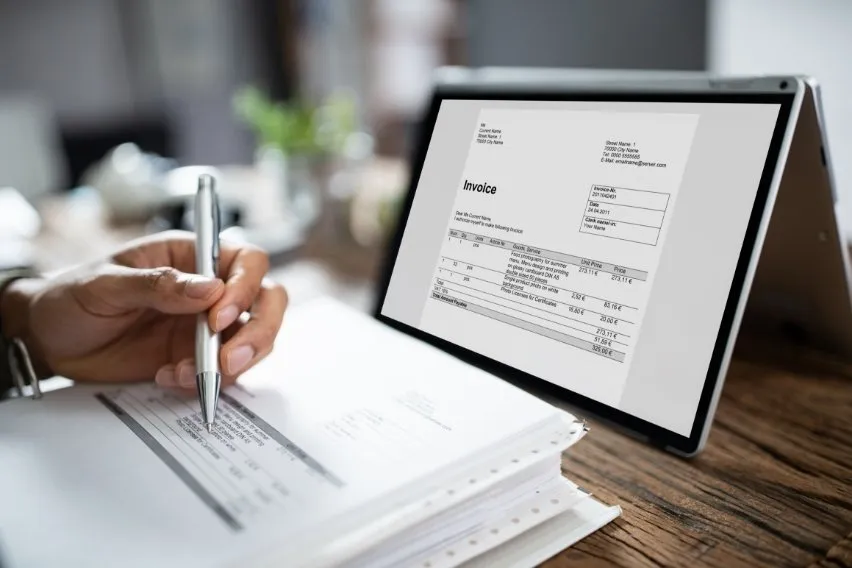Invoice Management: Definition & Benefits

Do you currently have an invoice management process? Implementing an invoice management system can make your life a whole lot easier. Why? Because it can be a challenge to stay on top of different areas. These can include duplicate payments, company records, and paper invoices. Plus, manual data entry and invoice approvals can be time-consuming.
Invoice management will make your life easier. Plus, it will make things more efficient for your accounts payable department. Yet, where are you supposed to start when it comes to invoice automation? There are plenty of invoice management tools to help approve invoices and pay supplier invoices.
Keep reading to learn all about the benefits of invoice management. We’ll also cover how it works, the importance, and more!
Table of Contents
Importance Of Invoice Management
Flaws Of Traditional Invoice Management
How Modern Invoicing Process Should Look Like
Benefits Of Automated Invoice Management
What Is Invoice Management?
Invoice management gets used by businesses to monitor and settle supplier invoices. It’s also referred to as invoice processing. The simplest version entails receiving a third-party invoice and confirming its legitimacy. Then, you pay the supplier, and record the payment in the business’s records.
At the end of the day, this doesn’t sound too difficult. However, there are often several parties involved. This means there are even more opportunities and chances for error. For instance, invoices get delivered to the customer who uses the service. They’re often the point of contact within the company. This invoice needs to get forwarded because this person is not often a member of the finance team. They’re also not likely an accounts payable clerk.

Importance of Invoice Management
A crucial internal business function involved in procurement procedures is invoice management. It includes the administration and processing of vendor and supplier invoices. Invoice management is the procedure where companies receive an invoice from a vendor. Then, they confirm its validity, pay the supplier, and record the payment.
The profitability of a business can get impacted by good invoice management and timely vendor payments just as much as by revenue. Most of the bottlenecks with conventional invoice processes get eliminated by automating everything.
The purchase process becomes entirely more streamlined. As well, the invoice route is more transparent and time and money get saved. Further, employee productivity gets increased and vendor relationships are strengthened. Automating your invoice management can make a huge difference in your daily operations.
FreshBooks offers an incredibly powerful solution that you can benefit from. You and your team can keep track of time spent on projects in FreshBooks. These projects get given to specific clients, and you can easily invoice your clients using the time that has been tracked.
One of the best parts is that you can gather all unbilled time from one or more projects that you, your contractors, and your employees have tracked. Then, you can put everything onto a single invoice. This additionally designates those time entries as automatically billed. You can bill for any unbilled expenses associated with the projects or your client at the same time that you create an invoice.
In large, well-established companies, the accounts payable procedure frequently includes invoice management. The role of accounts payable is to ensure vendors get paid and you receive the supplies and services your business requires to succeed.
Accounts payable teams collaborate with other staff members to ensure they have what they need. This can be incredibly important since there can be many moving parts to the entire invoicing process. This can apply to equipment, software, and even independent contractors and consultants. These are all accompanied by invoices that must get paid.
Flaws Of Traditional Invoice Management
In most businesses, invoice management falls under the purview of accounts payable. One or two employees handle all of the tasks involved in the workflow for managing invoices in small businesses.
They accept the invoice from the supplier and then examine it to make sure it is accurate. Next, they approve payment and pay the invoice document for historical purposes. Although this process seems simple, there are additional tasks that get connected. These can include:
- Providing support for a variety of payment methods
- Vendor record registration, validation, and updates
- Currency conversion
- Payment reconciliation
- Tax reporting
- Collecting tax forms
As well, invoice management can become even more difficult since there are different types of invoices. There are different documents, such as:
- The standard bill/invoice
- Credit notes
- Pro-forma invoices
- Time sheets
- Interim invoices
- And more
These are all categorized as invoices depending on the business competency and work style. As a result, each business must have an organized and comprehensive process for handling invoices. Manual management gets more and more difficult as the size of the business increases.
Traditional invoice management can be time-consuming and tedious work. This opens the door for a higher possibility of mistakes and errors. Plus, there can be significant delays and even cost penalties on top of a lack of compliance and control.
How Modern Invoicing Processes Should Look
Most companies have transitioned to automating their invoices, and this is only going to be the norm moving forward. Automating the entire invoice processing workflow can make the accounts payable process efficient. However, there are a few main areas worth focusing on.
- Receiving supplier invoices and purchase orders. Typically, invoices are received in a variety of formats. For example, they can be paper copies, online forms, and email attachments. The first step in invoice management is the automatic detection of electronic invoices. Then, you can extract data from those invoices.
- Extracting data and inputting it into enterprise resource planning (ERP) systems. Accurate data extraction is crucial. This is since each invoice has information for accounting and internal business decision-making. The information obtained from the invoices is then typically transferred to the company’s ERP. As well as to accounting or data analytics platforms for further processing.
- Performing digital payments. Automation makes it possible to choose the ideal payment terms and timings for paying vendors. The transparency of corporate liability and payment terms allows for payment schedule changes. In the end, you can take advantage of early payment discounts while delaying payment until the due date.
- Automated three-way validation. Automated three-way validation compares and matches records automatically. It does this before deciding whether to approve the transaction, point out errors, or raise exceptions.
Benefits Of Automated Invoice Management
Almost everywhere in business, automation can help improve processes. And it can be a lifesaver for tasks that are typically done manually, like processing invoices. Here are some of the main advantages of automated invoice management.
- Regular quick processing of invoices
- Elimination of payment delays and related issues. This includes work pauses and threatened vendor relationships, as well as the prevention of errors and data loss.
- Shifting of labor to more lucrative tasks
- Preservation of supply chain movement
- The avoidance of fraud
- Cost savings and time savings
- Greater control, visibility, and compliance
- Environmental responsibility and reducing paper clutter
- Improved document management and storage

Key Takeaways
Finding the right invoicing solutions for our accounts payable team doesn’t have to be a challenge. FreshBooks offers a great choice for your accounting software and approval workflows. You can save money, have better internal controls, and use one platform to pay vendors.
Invoice management will make a big difference when it comes to your invoice processing and how you send invoices. You can stay on top of late payments, avoid human error, and pay suppliers on time.
FAQs About Invoice Management
How do I reduce invoice errors?
Using automated invoice software is one of the best ways to reduce invoice errors. FreshBooks offers an easy-to-use solution that can help streamline your invoice processes.
What are the five uses of an invoice?
Invoices help track sales and inventory. Invoices also help forecast historical data and provide records for tax filing. As well, invoices itemize and record business transactions.
What should a good invoice include?
A good invoice needs to include an invoice number and company name and address of both your business and the customer. It should also include a description of what was provided, the date, and the total amount that needs to get paid.
RELATED ARTICLES


 Sales Order vs Invoice: Meaning & Difference
Sales Order vs Invoice: Meaning & Difference Invoice Discounting: Definition and Benefits
Invoice Discounting: Definition and Benefits Fake Invoice: How To Protect Your Business
Fake Invoice: How To Protect Your Business 8 Best Invoicing Software for Small Business (2025)
8 Best Invoicing Software for Small Business (2025) Automated Invoicing Processing: How Does It Work?
Automated Invoicing Processing: How Does It Work? Invoice vs Statement: What’s The Difference?
Invoice vs Statement: What’s The Difference?